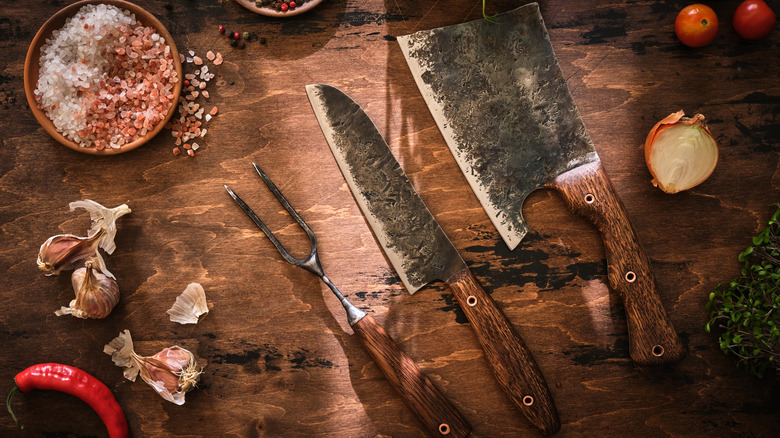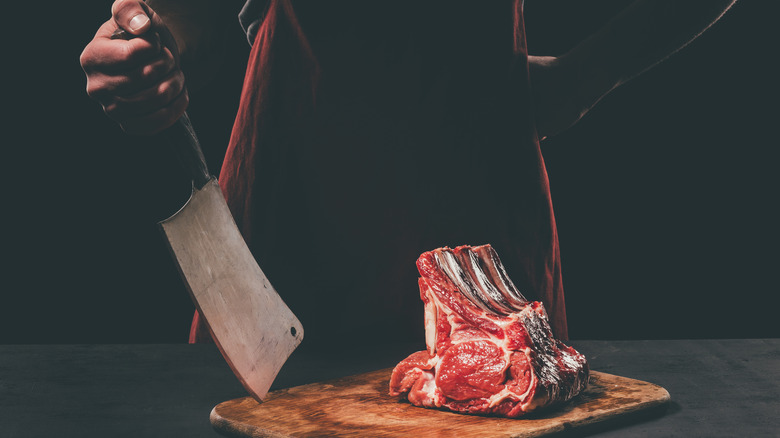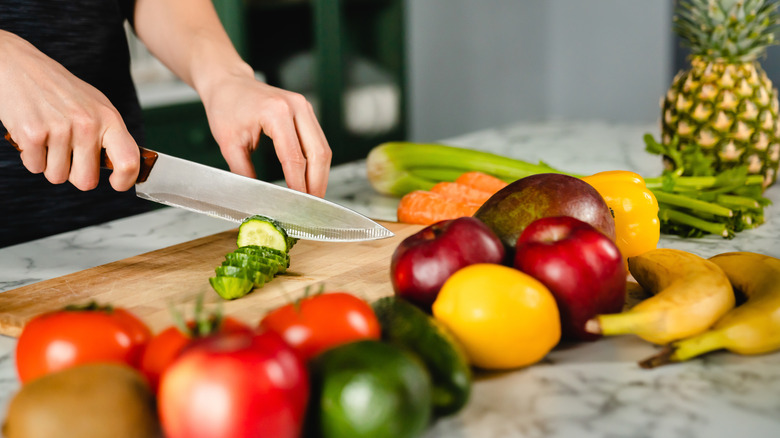Chef Vs. Butcher Knife: What's The Difference?
There's no shortage of articles and guides trying to teach folks that they don't need a complete knife set to be a great cook. Alton Brown says that only five knives are important for you to own. And Insider says that most home chefs can get by with one good knife. At the end of the day, it all comes down to personal needs and preferences. It's the same reason why most professional kitchens expect chefs to bring their own knife sets. Everyone has different priorities and cooks differently — the most important thing is to be properly equipped for what you plan to cut.
Two items that are both among the most symbolic for cooks and chefs are the butcher's knife, or meat cleaver, and the chef's knife. Both strike iconic silhouettes and can show off true culinary skills when properly used. Both are fairly versatile, but the two blades also have their specialties — you just need to figure out which you favor.
Different shapes for different needs
The most noticeable differences between these blades are their size, shape, and weight. According to Escoffier, a chef's knife is relatively light, usually between eight and ten inches in length, and its blade has a curved edge that comes to a point. This makes it well suited to slicing and rocking techniques, per Serious Eats.
Le Creuset says that a good chef's knife will "feel like an extension of your hand." Because this is a mid-size blade, there's little that this knife can't do, and that's why it's ranked as one of the most popular knives among cooks.
Then there is the much larger, heavier, but no less versatile butcher's knife or meat cleaver. Alliance Online says that butcher's knives can come in a variety of sizes depending on their usage, but always feature a wide, rectangular blade that usually has a hole in the corner so it can be hung instead of fit inside a knife block. Chef Sac points out that one of the biggest benefits of the butcher's knife is its weight. This heavier blade allows you to put more energy behind a cut when needed, and its high handle also allows you to chop without worrying about hitting your hand on the cutting board.
Both of these designs aren't just for aesthetics, though; they're both designed with particular uses in mind.
How to use each blade
Le Creuset says that a chef's knife is the most versatile knife available. It can perform a variety of tasks, from crushing garlic, cutting herbs, and chopping vegetables in prep to carving well-roasted meats. If you need a well-rounded workhorse blade, then look no further. Where it falls short compared to the butcher's knife is its striking power.
Chef Sac points out that butcher's knives were specifically designed to handle cutting through large chunks of meat and bone. A few good chops can quickly turn slabs of meat into manageable sizes. Encountering bone or sinew won't make a difference either, as the heavy, sharp blade slices through it all.
Martha Stewart adds that cleavers aren't only for serious carnivores, though. The straight-edged blade of a vegetable cleaver can be great for chopping large, tough veggies like sweet potatoes and butternut squash. The wide blade is also great at crushing garlic or scooping up diced veggies when laid flat.
Chef Sac says that gripping the cleaver like a chef's knife allows you to slice and dice any vegetable. Although if you prefer this knife, you will need to get comfortable picking the knife up off the table after each cut, as it doesn't allow for a rocking motion like a chef's knife. Either knife will serve you well in the kitchen, but if you're lacking a heavier knife, the cleaver should have a place of honor on your wall.


